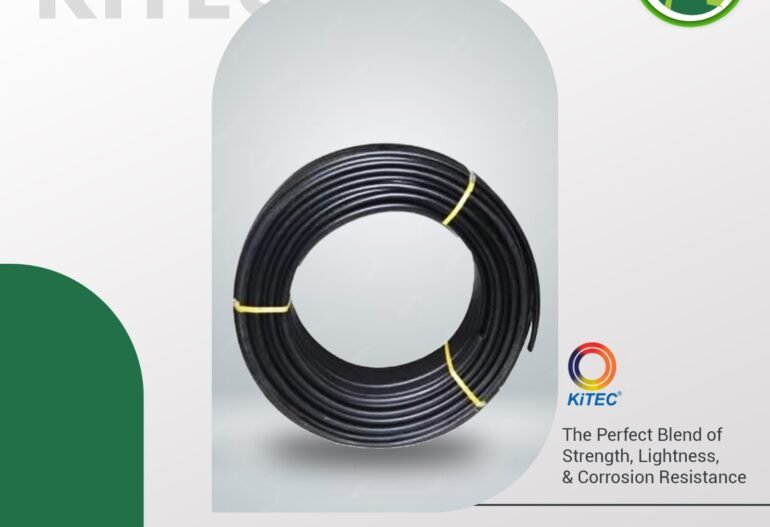In today’s plumbing and heating systems, it matters which type of pipe is being used for performance, longevity, and affordability. Among the commonly utilized pipes in residential homes and commercial buildings is the Kitec composite pipe. Known for its simplicity to install and flexibility, it has also had its share of news topics due to several issues over the years. In this post, we will deconstruct what a Kitec composite pipe is, where it is located, its pros and cons, and what homeowners should know today.
What is a Kitec Composite Pipe?
Its structure is quite unusual: plastic on the inside and the outside, with a thin layer of aluminum in the middle. This structure provides the pipe with strength, flexibility, and immunity to corrosion. First introduced in the 1990s, it gained popularity very quickly for use with both hot water and cold water supply lines, radiant floor heating systems, and even for some industrial applications.
Why Was Kitec Composite Pipe So Popular?
There are a number of reasons why the Kitec composite pipe has been such a popular choice among many builders and plumbers:
Easy to Install: The pipes are flexible and can be bent, which means fewer fittings are needed. This makes it faster to install.
Lightweight: Due to its plastic-aluminum-plastic design, it is significantly lighter than the old metal pipes, such as copper or steel.
No Rusting: The plastic wraps stop rust or scale formation, ensuring clean water flow.
Cost-effective: During its introduction, Kitec was less expensive than copper plumbing, which encouraged builders to use it.
Temperature Resistant: It could provide service for both hot and cold water lines, so it was applicable for multiple uses.
Where Was It Used?
The Kitec composite pipe was predominantly used in:
Residential plumbing systems (particularly in homes constructed from 1995 to 2007)
Radiant in-floor heating systems
Hot and cold water supply lines
Commercial plumbing in low-pressure systems
Problems with Kitec Pipes
Although the Kitec composite pipe initially appeared flawless, problems started to emerge with time. In the mid-2000s, there were complaints of pipe failures, particularly in hot water pipes. The major issues were:
Pipe Deterioration: A few pipes started to deteriorate prematurely, particularly under high pressure or heat.
Fitting Corrosion: Brass fittings on Kitec pipes had high zinc content, which triggered a process referred to as “dezincification.” This weakened the fittings and caused them to leak.
Sudden Leaks: At times, pipes would burst without notice, causing water damage and expensive repairs.
Due to these problems, the product was recalled, and a class-action suit was brought against the manufacturer.
Legal Action and Settlement
Because of the far-reaching issues, a class-action suit was brought in both the U.S. and Canada. The settlement addressed plumbing failures, the cost of replacement, and damage to properties due to these pipes.
Homeowners were encouraged to inspect their properties for any Kitec plumbing and make a claim before the deadline.
How to Know If You Have a Kitec Composite Pipe
If you are not sure if your house has Kitec plumbing, check it out using the following methods:
Labels: Pipes can have names such as Kitec, PlumbBetter, IPEX, AmbioComfort, or KTC.
Brass Fittings: Check for yellow brass fittings that join the pipes. Those fittings were in part responsible.
You can also have a licensed plumber visit your house and provide you with professional advice.
Should You Replace Your Kitec Plumbing?
If your home still contains Kitec composite pipe, replacement is highly advised, particularly if the pipes are utilized for hot water runs. While not all pipes fail, the risk is considerable enough that numerous insurance companies will not offer protection to homes that contain Kitec plumbing.
A few of the main reasons to replace:
Peace of Mind: Prevent unexpected leaks or pipe failures.
Insurance: Your policy may not include coverage for water damage in case the pipes burst.
Safer Modern Alternatives to Kitec Composite Pipe
Modern, safer alternatives include a number of options:
PEX (Cross-linked Polyethylene): Flexible, robust, and cost-effective.
CPVC (Chlorinated Polyvinyl Chloride): Both hot and cold water rated, simple to install.
Copper Pipes: Time-honored and durable, but pricey.
All of these options are favored by professionals and have proven to be enduring.
Final Thoughts
Whether you have existing Kitec plumbing or are purchasing a home that may contain it, always have a licensed plumber advise you of your choices. Replacing Kitec with safer piping will spare you future surprise repairs and ensure peace of mind for years to come








